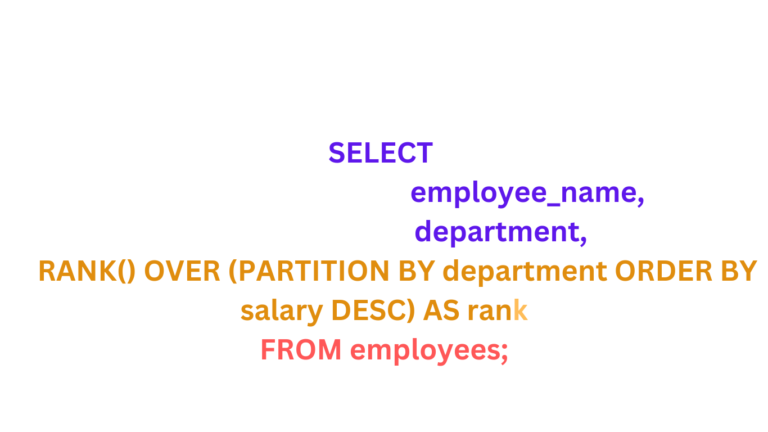Window Functions in SQL Introduction: Unlocking Advanced Querying
Window functions in SQL are a strong tool that may be used to do calculations over a collection of rows that are pertinent to the current record in a query. The result set is not decreased by window functions, as compared to aggregate functions. Instead, they return a value for every row, enabling advanced data analysis capabilities such as ranking, running totals, and trends.
Window functions help you unlock the potential of your data by combining detailed row-level analysis with summary-level insights, making them indispensable for data analysts and developers.
Understanding the Syntax and Structure of SQL Window Functions
The basic structure of a Window Function in SQL includes the function itself and the OVER clause. The OVER clause defines the window or subset of rows the function will operate on.
Syntax Example:
FUNCTION_NAME() OVER (PARTITION BY column_name ORDER BY column_name)- FUNCTION_NAME(): The specific window function (e.g., ROW_NUMBER(), SUM()).
- PARTITION BY: Divides the result set into partitions.
- ORDER BY: Specifies the rows’ arrangement within each partition.
Understanding this structure is key to writing efficient and meaningful queries.
Why Use Window Functions in SQL? Key Benefits Explained
Window functions provide several benefits, including:
- Non-aggregative Insights: They calculate values for each row without collapsing the result set.
- Custom Data Analysis: They allow calculations like running totals, ranks, and moving averages.
- Flexibility: They integrate seamlessly with existing SQL queries.
- Improved Performance: By avoiding subqueries, window functions simplify query optimization.
With these benefits, a Window Function in SQL becomes an essential tool for handling complex data operations efficiently.
Regular examples of use for Window Functions in Data Analysis
Some common applications of Window Functions in SQL include:
- Ranking Rows: Assigning ranks to rows based on specific criteria.
- Calculating Running Totals: Cumulative sums across rows.
- Moving Averages: Smoothing data trends over a window.
- Finding Trends: Comparing current rows with previous or future rows.
- Identifying Top N Records: Filtering top results within partitions.
These use cases make window functions a favorite in business intelligence and reporting.
Breaking Down SQL Window Functions: PARTITION BY and ORDER BY
The PARTITION BY and ORDER BY clauses define the scope and sequence of a window function:
- PARTITION BY: Divides the dataset into subsets for independent calculations.
- ORDER BY: Determines the sequence of rows within each partition.
Example:
ROW_NUMBER() OVER (PARTITION BY department ORDER BY salary DESC) AS rankHere, employees are ranked by salary within each department.
How ROW_NUMBER(), RANK(), and DENSE_RANK() Work in SQL
- ROW_NUMBER():Allocates a distinct number to every row in a partition.
- RANK(): Assigns ranks but skips numbers for ties.
- DENSE_RANK(): Similar to RANK() but does not skip ranks for ties.
Example:

This ranks employees by salary within each department.
Using NTILE() for Data Distribution: A Practical Guide
The NTILE() function divides rows into a specified number of groups and assigns a group number to each row. It is useful for percentile analysis or even data distribution.
Example:
SELECT employee_name, NTILE(4)
OVER (ORDER BY salary DESC) AS quartile FROM employees;Here, salaries are divided into four quartiles.
Calculating Running Totals and Moving Averages with SQL Window Functions
Running totals and moving averages can be computed using window methods like SUM() and AVG():
Running Total Example:
SELECT transaction_id,SUM(amount) OVER (ORDER BY transaction_date)
AS running_total FROM transactions;Moving Average Example:
SELECT transaction_id,
AVG(amount)
OVER (ORDER BY transaction_date ROWS BETWEEN 2 PRECEDING AND CURRENT ROW)
AS moving_avg FROM transactions;These functions are invaluable for trend analysis.
Lag and Lead Functions: Navigating Data Trends with SQL
The LAG() and LEAD() functions allow you to access previous or subsequent rows within the same result set:
Example:
SELECT employee_id, salary,
LAG(salary) OVER (ORDER BY employee_id) AS previous_salary,
LEAD(salary) OVER (ORDER BY employee_id) AS next_salary FROM employees;These functions are useful for identifying trends and comparing data points.
Practical Examples of Window Functions in Real-World SQL Queries
Example 1: Ranking Products by Sales
SELECT product_name, RANK() OVER (ORDER BY sales DESC) AS rank
FROM products;Example 2: Customer Purchase Trends
SELECT
customer_id,
purchase_date,
LAG(purchase_date)
OVER (PARTITION BY customer_id ORDER BY purchase_date)
AS previous_purchase FROM purchasesThese illustrations show how window features can be used for a variety of daily tasks.Optimizing SQL Queries with Window Functions: Best Practices
- Minimize Partitions: Avoid excessive use of PARTITION BY for large datasets.
- Indexing: Ensure proper indexing on columns used in ORDER BY.
- Combine with CTEs: Use Common Table Expressions for clarity.
- Test Performance: To maximize query performance, review execution plans.
Challenges and Limitations of Window Functions in SQL
While powerful, window functions have limitations:
- Performance Overheads: Processing large datasets can be resource-intensive.
- Learning Curve: Understanding syntax and use cases requires practice.
- Not Always Supported: Some SQL dialects lack full window function support.
To overcome these obstacles, detailed query planning and optimization are needed.
Frequently Asked Questions About Window Functions in SQL
Q1: What is a Window Function in SQL?
A Window Function in SQL performs calculations across a subset of rows related to the current row without reducing the result set.
Q2: How is a window function different from an aggregate function?
Window functions return a value for each row, while aggregate functions collapse the result set into a single value.
Q3: What are common use cases for window functions?
Ranking rows, calculating running totals, finding moving averages, and identifying trends.
Q4: Can window functions improve query performance?
Yes, when used correctly, they can simplify queries and reduce reliance on complex subqueries.
Q5: Are window functions supported in all SQL databases?
Most modern databases like PostgreSQL, SQL Server, and MySQL support window functions, but implementation may vary.
